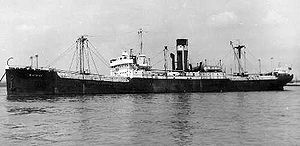SS Blairspey

| |
| Career | |
|---|---|
| Name: | SS Blairspey |
| Operator: | George Nisbet & Co, Glasgow |
| Builder: | Ardrossan Dockyard & Shipbuilding Co Ltd, Ardrossan |
| Yard number: | 344 |
| Launched: | 5 September 1929 |
| Completed: | October 1929 |
| Renamed: |
Empire Spey in 1942 Blairspey in 1946 Evandros in 1961 |
| Fate: | Scrapped in May 1967 |
| General characteristics | |
| Class and type: | Steam merchant ship |
| Tonnage: | 4,155 tons |
| Length: | 372 ft |
| Propulsion: |
Three cylinder triple expansion steam engines single screw |
| Crew: | 34 |
The SS Blairspey was a steam merchant ship that saw service during the Second World War. She was part of the ill-fated convoy SC-7, but despite being hit by at least three torpedoes from two different U-boats, managed to reach port.[1]
Early career
Blairspey was built by the Ardrossan Dockyard & Shipbuilding Co Ltd, Ardrossan, was launched on 5 September 1929 and completed in October 1929. She was operated by George Nisbet & Co and was homeported in Glasgow.[1] On the outbreak of the Second World War she was used to carry important war material to the United Kingdom. Her first convoy was SC-7, which sailed from Sydney, Nova Scotia on 5 October 1940.[2] She sailed from Rimouski, Quebec to join the convoy at Sydney, carrying a cargo of timber. Having crossed the North Atlantic it was intended that she would continue on to Grangemouth.[1]
Convoy SC-7
The convoy was attacked by a number of U-boats on the night of 18/19 October, their wolf pack tactics overwhelming the convoy escorts. At 23.08 hours on 18 October the convoy was attacked east-northeast of Rockall by U-101 under Fritz Frauenheim. He fired a number of torpedoes and claimed to have sunk two 9,500 ton ships, and damaged a third with an estimated 6,000 tons.[1] Allied records show that only the Blairspey had been hit, by at least one and possibly two torpedoes. Heavily damaged but still afloat she began to fall behind the convoy. She pressed on, but was sighted again at 02.50 hours on 19 October by U-100, under Joachim Schepke. He attacked her, hitting her with another two torpedoes.[1] Her cargo of timber kept her afloat, despite a badly damaged bow. She was taken in tow and eventually managed to reach port. She was beached in the Clyde on 25 October.[3]
Later career
The Ministry of War Transport was desperate for shipping, and arranged for Blairspey to be repaired. A new bow was built for her by Lithgows, Port Glasgow and was launched on 16 February 1942. The damaged section was removed during periods in the Garvel Drydock, Greenock, and the stern and new fore part were joined together in the same drydock, between 17 February 1942 and 19 March 1942.[3] She was taken over by the Ministry of War Transport and renamed Empire Spey, but continued to be operated by George Nisbet & Co. She served on three more Atlantic convoys, and survived the war.[2] She was returned to George Nisbet & Co in 1946, and renamed Blairspey. They sold her on, and she spent several years as a tramp steamer.[3] By 1961 she had been renamed Evandros and was operating under the Lebanese flag for a number of London Greeks. She served for a further six years, before being broken up in La Spezia in May 1967.[1]
References
- Blairspey at Uboat.net
- Blairspey at Clydebuilt.net
- The new bow of Empire Spey at Clydebuilt.net
- Arnold Hague's convoy database
| ||||||||||||||||||||||||||
